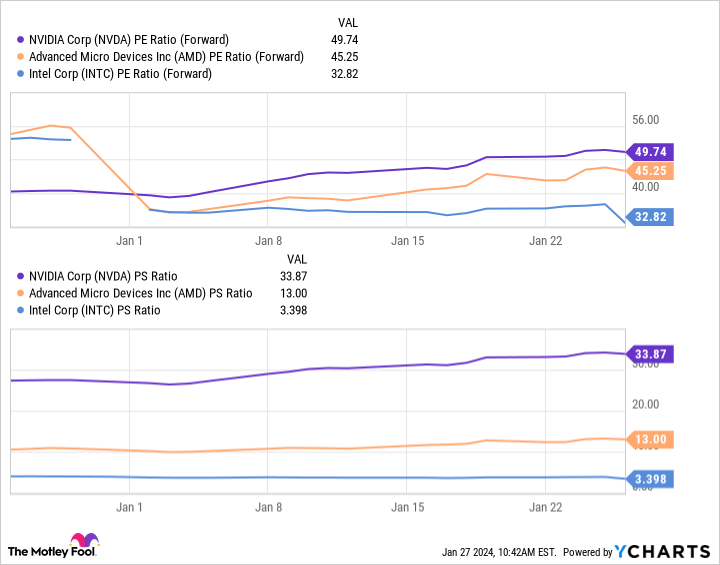Shares in Intel (INTC 0.43%) are down nearly 13% since Jan. 25 when it reported fourth quarter of 2023 earnings. The company posted revenue growth of 10% year over year, beating Wall Street estimates by $230 million. During the quarter, Intel enjoyed significant gains from a recovering PC market.
However, that wasn’t enough to overshadow weak guidance that sent its stock tumbling. Intel expects Q1 2024 earnings to reach $0.13 per share when analysts forecasted $0.42 per share. Meanwhile, the company projects revenue to come in between $12 billion to $13 billion, considerably below the $14 billion that Wall Street expected.
However, weak guidance is why it’s crucial to keep a long-term perspective when it comes to tech stocks. Intel has had a challenging few years but is restructuring its business to prioritize profits while also investing in high-growth sectors like artificial intelligence (AI).
Here’s why Intel’s stock remains a buy in 2024.
Rebuilding Intel will require patience but could pay off over the long term
Intel has had a challenging few years, to say the least. The company was responsible for more than 80% of the central processing unit (CPU) market for at least a decade and was the primary chip supplier for Apple‘s MacBook lineup for years. However, Intel’s dominance saw it grow complacent, leaving it vulnerable to more innovative competitors.
Chip rival Advanced Micro Devices started gradually eating away at Intel’s CPU market share in 2017, with Intel’s share now down to 69%. Then, in 2020, Apple cut ties with Intel in favor of more powerful in-house hardware designs. As a result, Intel’s stock is down 21% over the last three years.
However, the fall from grace has seemingly lit a fire under Intel again, and it is making moves to come back strong in the coming years. Last June, Intel announced a “fundamental shift” to its business model, adopting an internal foundry model that it believes will help it save $10 billion by 2025.
The model will see Intel transform from a primarily integrated device manufacturer to a business similar to Taiwan Semiconductor Manufacturing, becoming a major provider of foundry capacity in North America and Europe. Intel says a foundry-style relationship with its manufacturing group could increase efficiency and profitability, enabling it to hit non-GAAP gross margins of 60% and operating margins of 40%.
It will take time, but it could be worth sticking with Intel through its restructuring.
Intel remains one of the cheapest AI chip stocks
In addition to a shift in business models, Intel is heavily investing in AI, a market projected to surpass $1 trillion before 2030. The company debuted a range of AI chips last December, including Gaudi3, a graphics processing unit (GPU) designed to challenge similar offerings from Nvidia.
Additionally, Intel showed off new Core Ultra processors and Xeon server chips, which include neural processing units for running AI programs more efficiently.
Chip stocks skyrocketed last year alongside a boom in AI as demand for GPUs soared. Nvidia took center stage, with its shares rising 239% in 2023, while AMD’s stock rose 127%. Intel’s stock also saw significant growth, increasing 90% last year. However, its more moderate rise means its shares are trading at a better value than its two biggest chip rivals.
Data by YCharts.
This chart shows Intel’s forward price-to-earnings ratio (P/E) and price-to-sales (P/S) are significantly lower than the same metrics for Nvidia and AMD.
Forward P/E and P/S are two helpful valuation metrics when considering investing in a stock as they take into account a company’s financial health. Forward P/E is calculated by dividing a stock’s current share price by its estimated earnings per share (EPS). Meanwhile, P/S divides its market cap by its trailing-12-month revenue. With both, the lower the figure, the better the value.
Intel’s considerably lower figures for both metrics make it a lower risk than AMD and Nvidia. And, Intel is an excellent stock to buy in 2024 and hold over the next decade as the company rebuilds its business for the better.
Dani Cook has no position in any of the stocks mentioned. The Motley Fool has positions in and recommends Advanced Micro Devices, Apple, Nvidia, and Taiwan Semiconductor Manufacturing. The Motley Fool recommends Intel and recommends the following options: long January 2023 $57.50 calls on Intel, long January 2025 $45 calls on Intel, and short February 2024 $47 calls on Intel. The Motley Fool has a disclosure policy.




